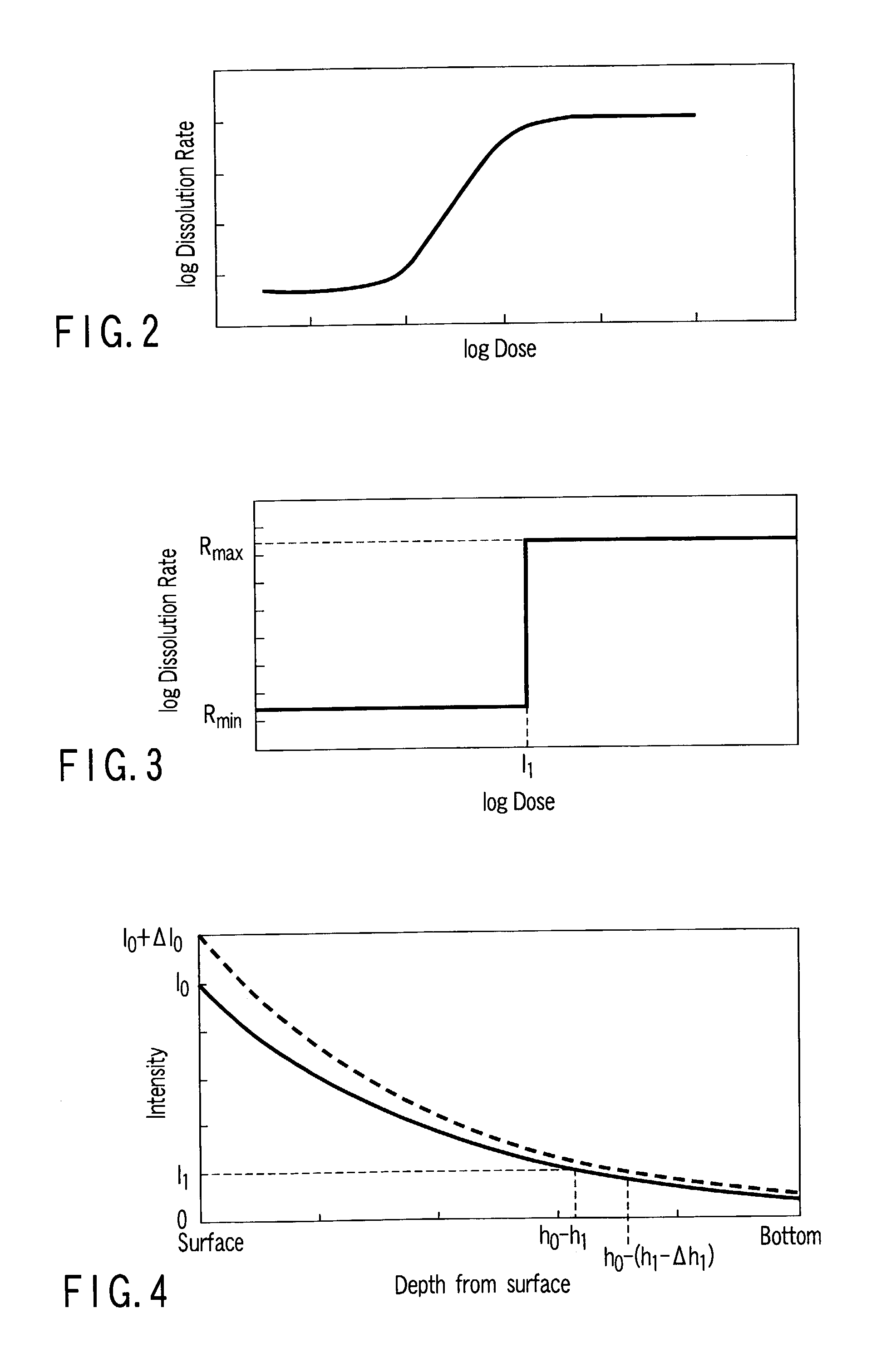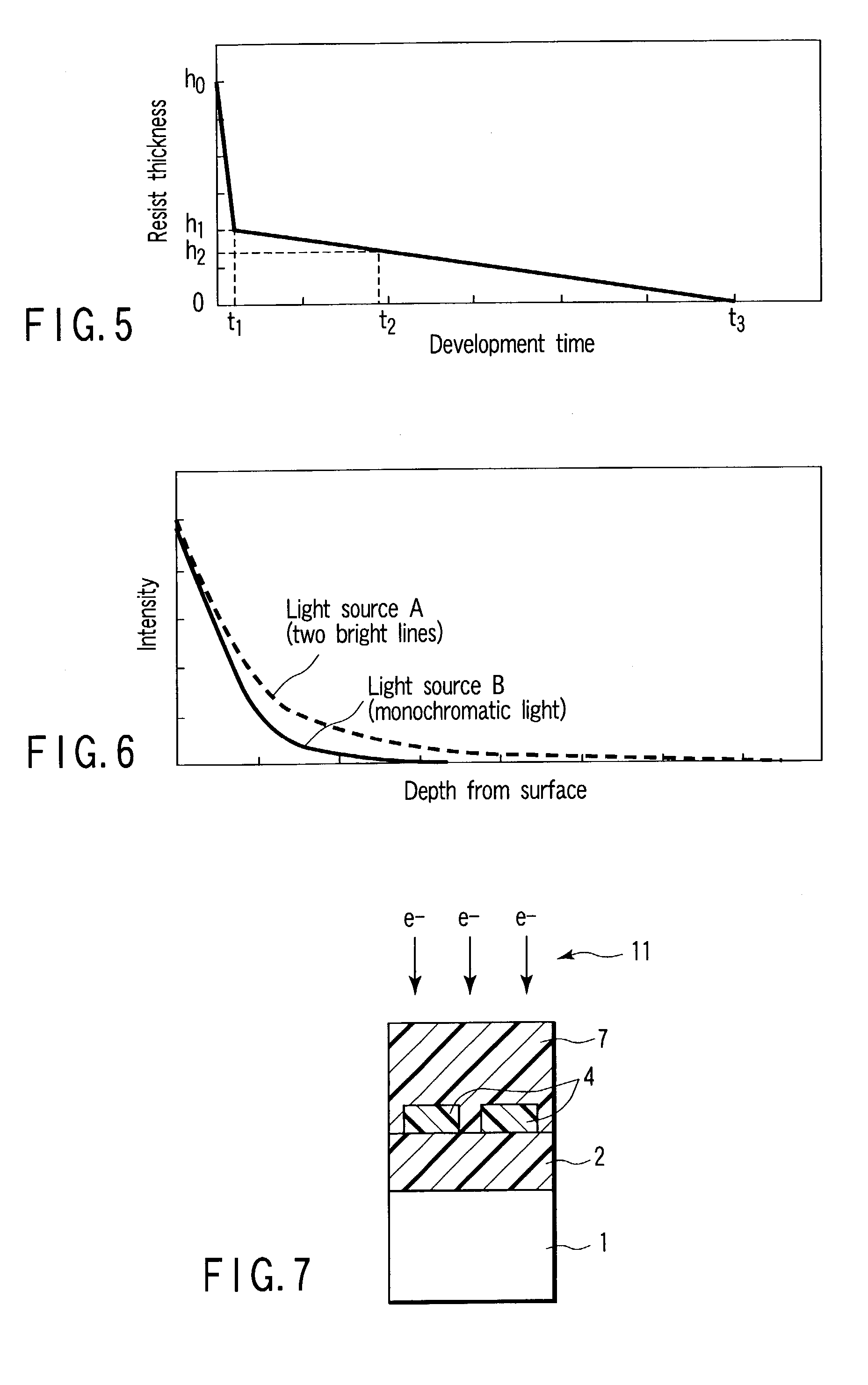Pattern forming method and method for manufacturing semiconductor device
a technology of semiconductor devices and forming methods, which is applied in the field of pattern transfer processes, can solve the problems of short wavelength, difficult to develop resist films having a high light transmittance for such a very short wavelength, and decrease the resistance of resist films to dry etching
- Summary
- Abstract
- Description
- Claims
- Application Information
AI Technical Summary
Benefits of technology
Problems solved by technology
Method used
Image
Examples
first embodiment
(First Embodiment)
[0034]A first embodiment of the present invention will be described with reference to FIGS. 1A to 1I and FIGS. 2 to 6. FIG. 1A to FIG. 1I are cross-sectional views illustrating steps of a pattern forming method according to the first embodiment. FIG. 2 is a graph showing the relationship between a resist dissolution rate and an exposure amount (dose). FIG. 3 is a graph simplifying the graph of FIG. 2 by binarization. FIG. 4 is a graph showing a light intensity distribution in a depth direction in a case where a buried material is exposed with monochromatic light. FIG. 5 is a graph showing the relationship between a development time of a buried material and a residual film thickness (resist thickness). FIG. 6 is a graph showing a light intensity distribution in a depth direction in a case where a resist film is exposed with light components of plural wavelengths.
[0035]In the first embodiment, An ArF positive resist film is used as a resist film. A photosensitive pol...
second embodiment
(Second Embodiment)
[0080]A second embodiment of the present invention will now be described with reference to FIG. 7. FIG. 7 is a cross-sectional view depicting a step in a pattern forming method according to the second embodiment. The parts common to those in FIGS. 1A to 1I are denoted by like reference numerals, and a detailed description thereof is omitted. A semiconductor device manufacturing method according to the second embodiment is the same as the above-described semiconductor device manufacturing method according to the first embodiment, so a description thereof is omitted. The same applies to the descriptions of third to eighth embodiments which will follow.
[0081]The ArF excimer laser beam 8 with a wavelength of about 193 nm is used in the first embodiment in the all-surface exposure step of applying a radiation to the photosensitive polysilazane used as the positive-type radiosensitive compound film. In the second embodiment, the ArF excimer laser beam 8 is replaced with...
third embodiment
(Third Embodiment)
[0084]A third embodiment of the present invention will now be described with reference to FIGS. 8A to 8H. FIGS. 8A to 8H are cross-sectional views showing steps of a pattern forming method according to the third embodiment.
[0085]In the third embodiment, a DLC (Diamond Like Carbon) film is used as a to-be-processed film. A negative resist film for low-acceleration EB write is used as a resist film. Poly [p-(1,2-dimethyl diphenyl disilanylene)phenylene] is used as the buried material. A low-pressure mercury lamp is used as a light source for irradiating the buried material. The details of the third embodiment will follow.
[0086]To start with, as shown in FIG. 8A, a DLC (Diamond Like Carbon) film 21 with a thickness of about 0.3 μm, serving as a to-be-processed film, is provided on a semiconductor substrate 1.
[0087]Next, as shown in FIG. 8B, a low-acceleration EB write negative resist film 22 serving as a resist film is spin-coated on the DLC film 21 so as to have a th...
PUM
| Property | Measurement | Unit |
|---|---|---|
| light absorption coefficient | aaaaa | aaaaa |
| thickness | aaaaa | aaaaa |
| thickness | aaaaa | aaaaa |
Abstract
Description
Claims
Application Information
 Login to View More
Login to View More - R&D
- Intellectual Property
- Life Sciences
- Materials
- Tech Scout
- Unparalleled Data Quality
- Higher Quality Content
- 60% Fewer Hallucinations
Browse by: Latest US Patents, China's latest patents, Technical Efficacy Thesaurus, Application Domain, Technology Topic, Popular Technical Reports.
© 2025 PatSnap. All rights reserved.Legal|Privacy policy|Modern Slavery Act Transparency Statement|Sitemap|About US| Contact US: help@patsnap.com



